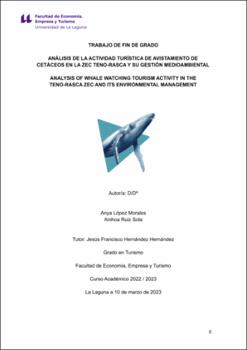Análisis de la actividad turística de avistamiento de cetáceos en la ZEC Teno-Rasca y su gestión medioambiental
Date
2023Abstract
With 16 million tourists per year (2019), the Canary Islands is one of the world's
leading sun and beach destinations. Although this development has been based
on standardised products, similar to other destinations, there has been a degree
of diversification in the offer, with new products that seek to take advantage of
comparative advantages. Within these new products, those linked to heritage
and environmental assets can be highlighted, which represents a challenge in
terms of making their tourist use compatible with the maintenance of their
heritage or environmental quality characteristics. In the case of Tenerife, there
are several examples, particularly the Teide National Park, which combines a
very high environmental quality, even classified as a World Heritage Site, with a
very high influx of tourists and visitors. A less studied aspect, but of great
interest, is the tourist use of marine reserves, as their non-terrestrial delimitation
represents an even greater challenge. In our work we study the case of the
tourist use of the ZEC Teno-Rasca, as it is located in the area of greatest tourist
development in Tenerife, and is home to particular biological communities,
especially cetaceans, as it is considered to be the most significant site in the
European Union, with some 80 species, the sighting of which is the main
objective of tourist use. Con 16 millones de turistas anuales (2019), Canarias es uno de los principales
destinos de sol y playa del mundo. Si bien este desarrollo se ha basado en
productos estandarizados, semejantes a otros destinos, se ha venido
produciendo un grado de diversificación en la oferta, con nuevos productos que
tratan de aprovechar ventajas comparativas. Dentro de estos nuevos
productos, pueden destacarse los que están vinculados a activos patrimoniales
y ambientales, lo que representa un reto para poder hacer compatible su uso
turístico y el mantenimiento de sus características de calidad patrimonial o
ambiental. En el caso de Tenerife, hay diversos ejemplos, particularmente el
Parque Nacional del Teide, en el que confluyen una muy elevada calidad
ambiental calificada incluso como Patrimonio de la Humanidad y una muy
elevada afluencia de turistas y visitantes. Un aspecto menos estudiado, pero de
gran interés, es el uso turístico de las reservas marinas, pues su delimitación
no terrestre supone un reto aún mayor. En nuestro trabajo estudiamos el caso
del uso turístico de la ZEC Teno-Rasca, en cuanto se sitúa en el área del mayor
desarrollo turístico de Tenerife, y alberga comunidades biológicas singulares,
especialmente de cetáceos, pues se considera el lugar de la Unión Europea
más significativo, con unas 80 especies, y cuyo avistamiento constituye el
principal objetivo de uso turístico.




